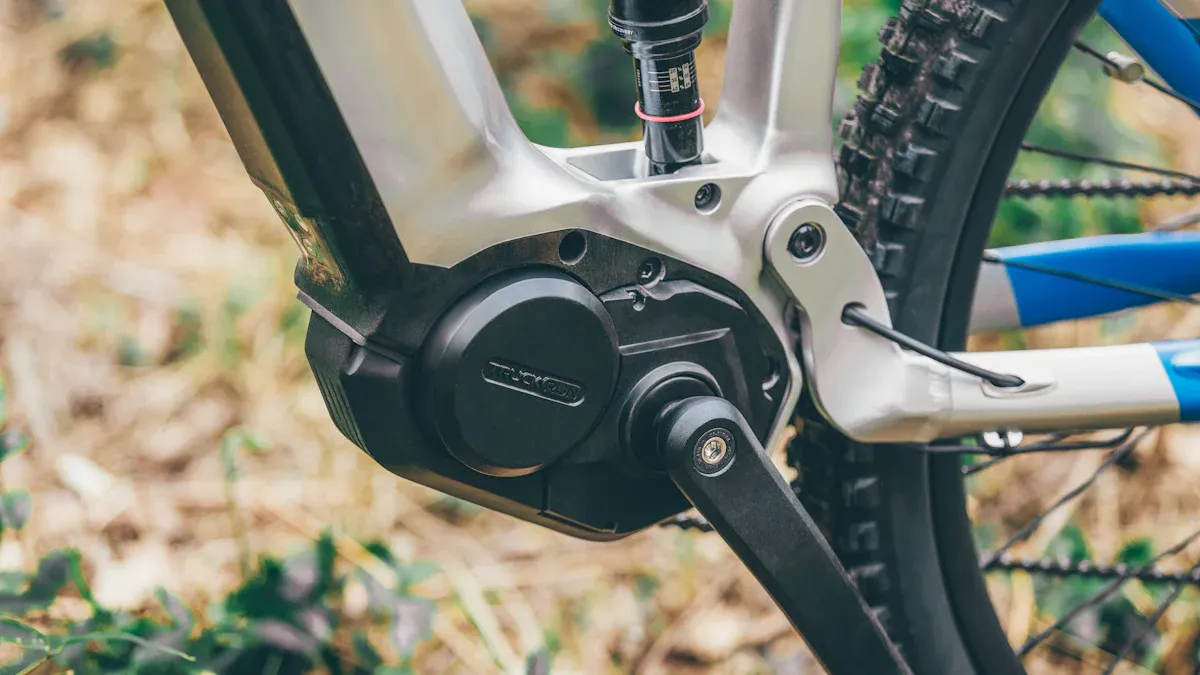
A rider goes down a rocky trail. The mountain bike frame moves with every bump. It also moves with every twist. Compliance means the frame bends and takes in vibration. This helps make the ride smoother and more comfortable. Riders feel better when the bike softens hard hits. A mountain bike with good compliance gives better control. It also gives more comfort. People who love bikes and those new to biking want comfort. This makes mountain trips more fun. The right frame with good compliance changes how every ride feels.
Tip: Knowing about compliance in a bike frame helps riders pick the best bike for comfort and performance.
Key Takeaways
Mountain bike frame compliance means the frame bends. This helps absorb bumps. It makes rides smoother. It also makes them more comfortable.
Picking the right mix of stiffness and compliance is important. It gives riders control. It also gives comfort on different trails.
Frame materials like steel, aluminum, titanium, and carbon fiber matter. They change how much a bike flexes. They also change how it feels on the trail.
Testing frames in labs and on trails helps riders. It helps them find the best bike. The bike should fit their weight, style, and riding goals.
Riders should try different bikes and setups. This helps them pick a frame that matches their needs. It should give comfort, control, and good performance.
Frame Compliance & Performance
Comfort vs Control
Mountain bike riders want both comfort and control. Frame compliance helps with this balance. When the frame bends, it takes in bumps from rough ground. This makes the ride smoother and less harsh. But if the frame bends too much, the bike does not respond quickly. This can make it harder to control on steep hills or sharp turns.
Riders try different frames to find what works best. If the frame is the wrong size, it can hurt and make riding hard. It also makes the bike tough to steer. To fix this, riders look at size charts and ask bike shop workers for help. Some get a professional fitting. These steps help make sure the bike fits their body and style. This way, they get both comfort and control on trails.
Test rides show that hardtail bikes give strong control but less comfort on bumpy hills. Cross-country bikes are built for speed, but may not be as comfy or easy to control. Bikes like the Specialized Turbo Levo let riders change how the bike handles. This helps them get the right mix of comfort and control. It also helps them do better on the trail.
Note: Setting up your bike for comfort and control is very important, especially when riding on different mountain trails.
Ride Quality Factors
Many things affect how a mountain bike feels to ride. The frame material has special features like elasticity, yield strength, tensile strength, fatigue strength, and density. These features decide how much the frame bends and how comfy the ride is.
Static load is the weight of the bike and rider.
Dynamic load comes from speeding up, stopping, and rough ground.
Frame twisting happens when you stand up to pedal or turn.
Jumps and drops put stress on the rear suspension, especially if the front and rear shocks are not the same stiffness.
How the frame is made also matters. Welding methods like TIG welding and heat treatments such as the T6 process make the frame stronger. These steps change the frame’s features in welded areas. This can change how the bike feels over time.
Frame stiffness, weight, strength, price, and how eco-friendly it is all matter for ride quality. Riders pick frames that fit what they want for comfort, control, and performance. The best mix of these things makes mountain biking more fun.
Frame compliance works with the suspension system to change how the bike rides. Where the pivots are placed in the suspension changes how the bike handles bumps and uses power. The table below shows how different pivot spots change the suspension and ride:
Pivot Placement | Effect on Suspension Behavior | Impact on Ride Quality | Pros | Cons |
|---|---|---|---|---|
Low Pivot | Suspension squats | Softer ride, better bump handling and grip | Smoother pedaling on rough ground, active suspension | Pedaling is less efficient, some power is lost |
High Pivot | Suspension resists squatting | Stiffer suspension, less bump softness, better pedaling | Good power transfer, suspension feels like hardtail | Less grip, rougher ride, possible power loss |
Aligned Pivot | Pivot matches chainline | Balanced pedaling, grip, and bump softness | Neutral suspension in ideal sag range | Performance drops outside ideal sag, some trade-offs |
Frame shape decides suspension geometry, pivot spots, and leverage ratio. These parts work together to control how the suspension moves and how force is used. Designs like Horst Link, single pivot, or VPP are built into the frame to make travel smooth, pedaling strong, and shock absorption better. This shows that comfort and control depend on both frame design and suspension setup.
Rider comfort is very important for mountain bikers. A frame that bends well takes in trail bumps, so riders get less tired and enjoy long rides more. The right amount of bending makes the ride better and helps performance. Riders who know about these things can pick a frame that fits their needs and gives both comfort and control on any mountain trail.
What Is Mountain Bike Frame Compliance?
Flex and Vibration Absorption
A mountain bike frame deals with many forces while riding. Riders feel bumps, rocks, and roots on trails. Compliance is how the frame bends and takes in shocks. When the frame flexes, it works like a spring. Steel frames show this best. Steel bends and gives back energy, which helps take in vibrations from rough ground. This spring-like action makes the ride smoother and keeps riders comfy.
Aluminum frames act in another way. Engineers make aluminum frames to have less flex. If aluminum bends too much, it can get small cracks over time. Carbon fiber frames are different. Builders can change the fiber direction and resin. This lets them make some parts of the frame more or less flexible. They can tune the frame for comfort and strength.
A frame with good compliance soaks up trail bumps and noise. Riders get less tired and have more control. Flex in the frame helps keep the wheels on the ground. This gives better grip. Comfort goes up, especially on long or rough rides. The right amount of compliance makes a mountain bike feel lively and smooth.
Tip: Riders who want more comfort should pick frames with controlled flex, especially if they ride on rocky or root-filled trails.
Stiffness vs Compliance
Engineers have a hard job when making a bike frame. They need to balance stiffness and compliance. Stiffness means the frame does not bend much. A stiff frame holds up the rider and reacts fast to steering and pedaling. Pro riders often pick stiff frames for sharp handling and strong power transfer. These frames help them control the bike at high speeds and when braking hard.
Compliance means the frame bends and takes in hits. More compliance gives more comfort and grip. Riders who spend hours on rough trails like compliant frames. These frames cut down on vibration and help riders stay fresh. But too much compliance can make the bike feel less steady. The frame might bend too much, which can make handling strange or cause problems with other parts.
Carbon fiber frames let engineers adjust stiffness and compliance. By changing the way fibers and resin are used, they make frames that give both comfort and control. Aluminum frames focus on being stiff to stop damage. Steel frames are naturally more flexible, so many riders who want comfort choose them.
Pro riders pick frames based on the trail and how they ride. They want a stiff front triangle for sharp steering. The rear triangle often has more flex to take in bumps. Handlebars matter too. Some riders use stiff bars for control. Others like bars that flex to stop hand pain. The best mix of stiffness and compliance depends on what the rider needs.
The table below shows how stiffness and compliance change ride quality:
Feature | Stiffness Benefit | Compliance Benefit | Trade-Offs |
|---|---|---|---|
Front Triangle | Precise steering | Less vibration absorption | May cause hand fatigue |
Rear Triangle | Strong power transfer | Better impact absorption | Possible flex interference |
Handlebars | Maximum control | Reduced hand fatigue | Less responsive at speed |
A mountain bike frame must handle side forces and things the suspension cannot take in. The right mix of stiffness and compliance gives better comfort, grip, and control. Riders should think about their weight, how they ride, and the trails they use when picking a frame. Some frames have adjustable parts, like seat stay bridges, to help change how the frame acts.
Note: Too much stiffness can make the ride rough and tiring. Too much compliance can lower control and make the bike less predictable.
Frame Science
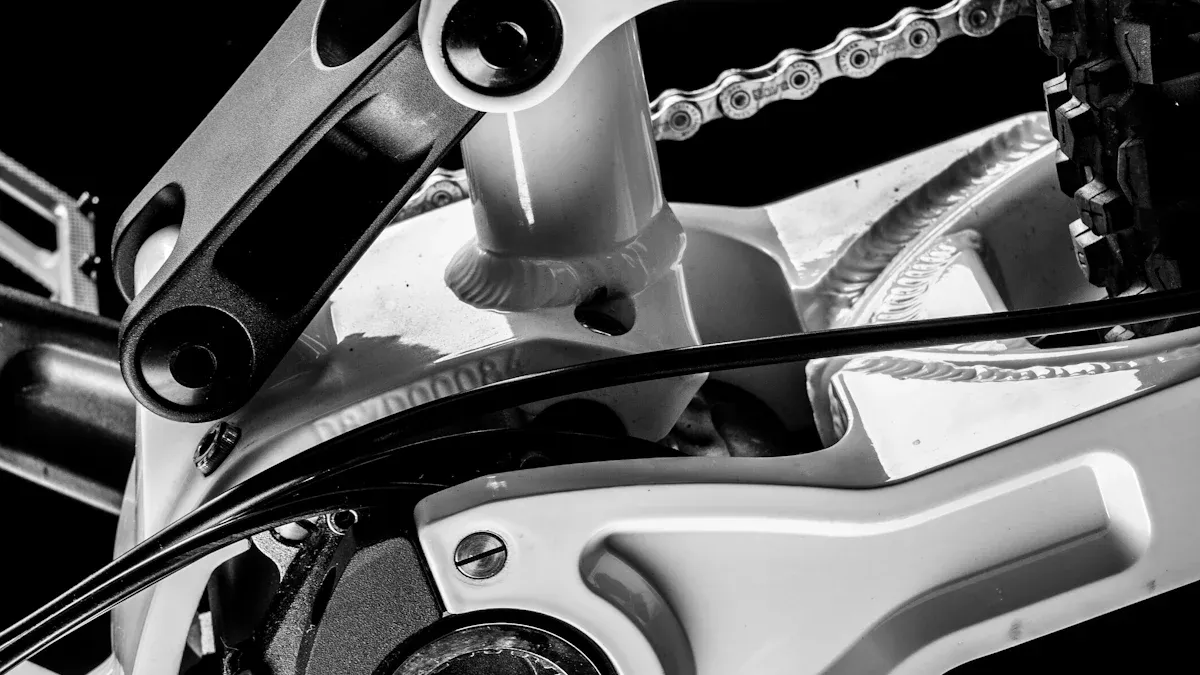
Physical Principles
Engineers work to make a bike frame both stiff and flexible. The frame faces many forces when you ride. Material properties like Young’s modulus and Poisson’s ratio decide how much the frame bends. The shape and size of the tubes change how the frame bends and twists. If the rear dropouts are fixed, it changes how the frame moves. The frame deals with forces like pushing, bending, twisting, and bumps from rough ground. Engineers use modeling methods like Euler–Bernoulli beam theory and finite element analysis to guess how the frame will act.
A finite element analysis of an aluminum frame uses beam elements. These elements show how the frame bends, twists, and stretches. Engineers put in material properties and frame shape. They also set boundary conditions. A sideways hit is used to copy real trail forces. This shows how compliance depends on mechanics and structural analysis.
Factor / Principle | Description / Role in Compliance |
|---|---|
Material Properties | Young’s modulus and Poisson’s ratio decide how much the frame bends and stretches. |
Frame Geometry | Tube size and shape change how the frame bends and twists. |
Boundary Conditions | Fixing parts like rear dropouts changes how the frame moves. |
Loading Conditions | Forces like pushing, bending, twisting, and bumps affect the frame. |
Modeling Methods | Beam theory and finite element methods help predict how the frame acts. |
Design Factors | Tube size, wall thickness, shape, and how it’s made change stiffness and flexibility. |
Dynamic Effects | Real trail bumps need special models to show how the frame acts in action. |
Engineers use these ideas to build bike frames that give riders the right mix of comfort and stiffness.
Lateral vs Vertical Compliance
A bike frame needs to handle sideways and up-and-down flex. Lateral compliance means the frame can bend sideways and twist. This helps grip and makes turning easier. If you take out a bridge in the rear triangle, the axle can move more sideways and twist more. This helps grip and makes cornering smoother. The back of the frame should flex sideways for grip. The front needs to be stiff for good steering.
Vertical compliance is how the frame takes in bumps from below. It lets the frame and wheels act like springs together. Their bending adds up. The front should be stiff to keep steering safe and sharp. The back can bend more to make the ride softer and help grip. How the wheel is built, like how many spokes it has, also changes how the frame bends and takes in force.
Fork compliance mixes stiffness for strong braking and flex for grip when leaning. New fork designs help balance these needs. How the frame splits forces between sideways and up-and-down flex changes comfort and control. Riders who know about these types of flex can pick a frame that fits their style and the trails they ride.
Materials & Design
Bicycle Frame Materials
The material of a bike frame changes how it feels to ride. Steel frames are strong and bend easily. This makes rides smooth and comfy. Many riders pick steel for long trips because it lasts and feels good. Aluminum frames are lighter than steel. They feel stiffer and bumpier. New ways of shaping aluminum help make it softer and more flexible. Titanium frames are light like aluminum but bend like steel. They soak up bumps and feel springy. Carbon fiber frames are special. Makers can change how stiff or soft they are by moving the fibers around.
Material | Compliance Characteristics | Additional Notes |
|---|---|---|
Steel | Great at soaking up bumps; bends well for smooth rides. | Heavy and can rust; some riders like it for comfort and strength. |
Aluminum | Stiff and bumpy, but new shaping makes it softer. | Light, does not rust, but wears out faster and is hard to fix. |
Titanium | Mixes steel’s bend with aluminum’s lightness; soft and springy. | Very costly and tough to make; does not rust. |
Carbon Fiber | Can be stiff or soft; stops vibrations well; shapes can be changed. | Very light and strong; costs a lot; breaks badly if damaged; hard to fix. |
Steel frames are heavy but smooth. Aluminum frames are light but stiff. Titanium frames are springy and light. Carbon fiber frames can be made to feel any way you want.
Carbon Fiber Layup
Carbon fiber layup lets makers change how a bike frame bends. Workers put fibers in different directions and layer them by hand. This helps make some parts stiff and others soft. Big layers help shape the frame. Small layers make strong spots where needed. Changing fiber types and glue helps control how the frame acts. New molds and better ways to build keep frames strong and even. Companies like Allied Cycle Works and Santa Cruz use these tricks to get the right shape and feel.
Tip: Carbon fiber layup helps make bikes fit what riders want. It lets makers change how the bike feels on the trail.
Tube Shape & Geometry
The shape and size of tubes change how a bike bends. Makers use thick and wide tubes in aluminum frames to make them stiff. Titanium frames use big tubes to stay light and bend well. Steel frames use small tubes because steel is already stiff. Carbon fiber frames can have cool shapes to make them stiff or soft. How a frame is built changes how it takes bumps, stops shakes, and listens to the rider.
Note: The way a frame is made matters more for bending than the material. Good building, strong parts, and care keep bikes safe and working well for a long time.
Measuring Bike Frame Stiffness
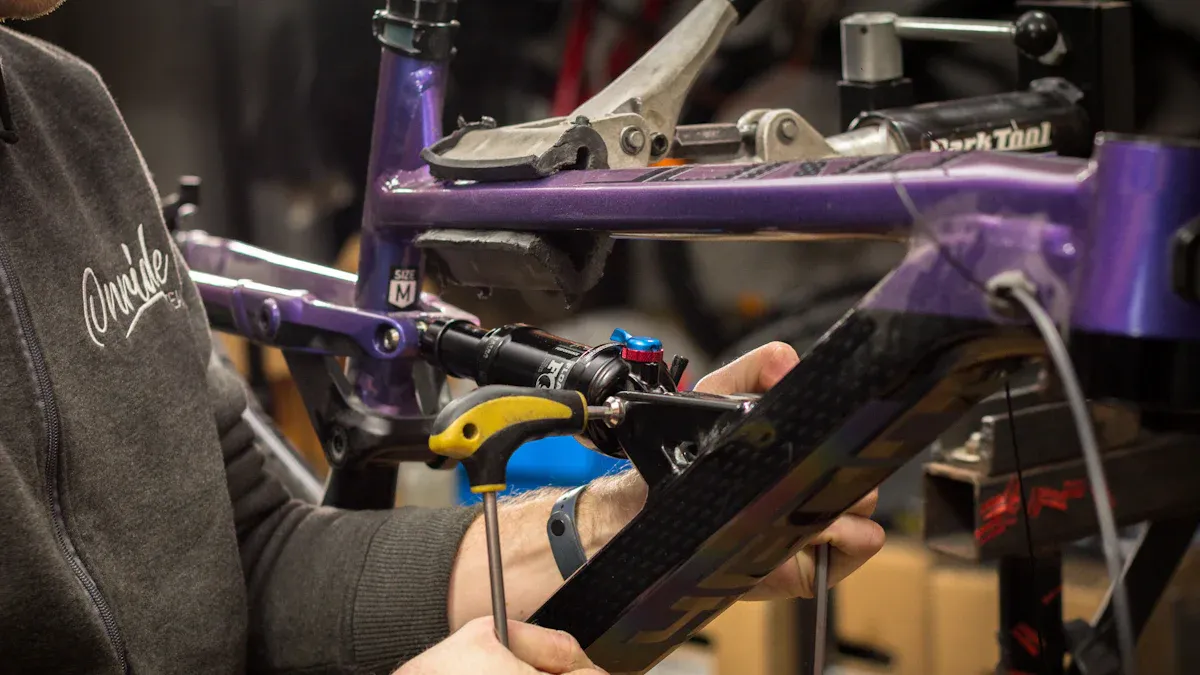
Lab Testing
Engineers use special tests to check bike frame stiffness. In labs, they push on different parts of the frame. They see how much each part bends. There are two main tests. One is the head tube deflection test. This test checks how stiff the steering is. Engineers push on the head tube and watch how much it twists. The other test is the bottom bracket deflection test. This test checks how stiff the pedaling area is. Engineers push on the bottom bracket and see how much it flexes.
Test Type | Description | Measured Parameter |
|---|---|---|
Head Tube Deflection Test | Checks steering stiffness by pushing on the head tube and seeing how much it twists. | Force per mm of deflection (N/mm) |
Bottom Bracket Deflection Test | Checks pedaling stiffness by pushing on the bottom bracket and seeing how much it flexes. | Force per mm of deflection (N/mm) |
These tests give clear results for how stiff and flexible a bike frame is. The amount of force needed to bend the frame is important. Different frame materials bend in different ways. Aluminum frames are stiffer for steering and pedaling than steel or titanium frames. The chart below shows how stiff each material is for steering and pedaling:
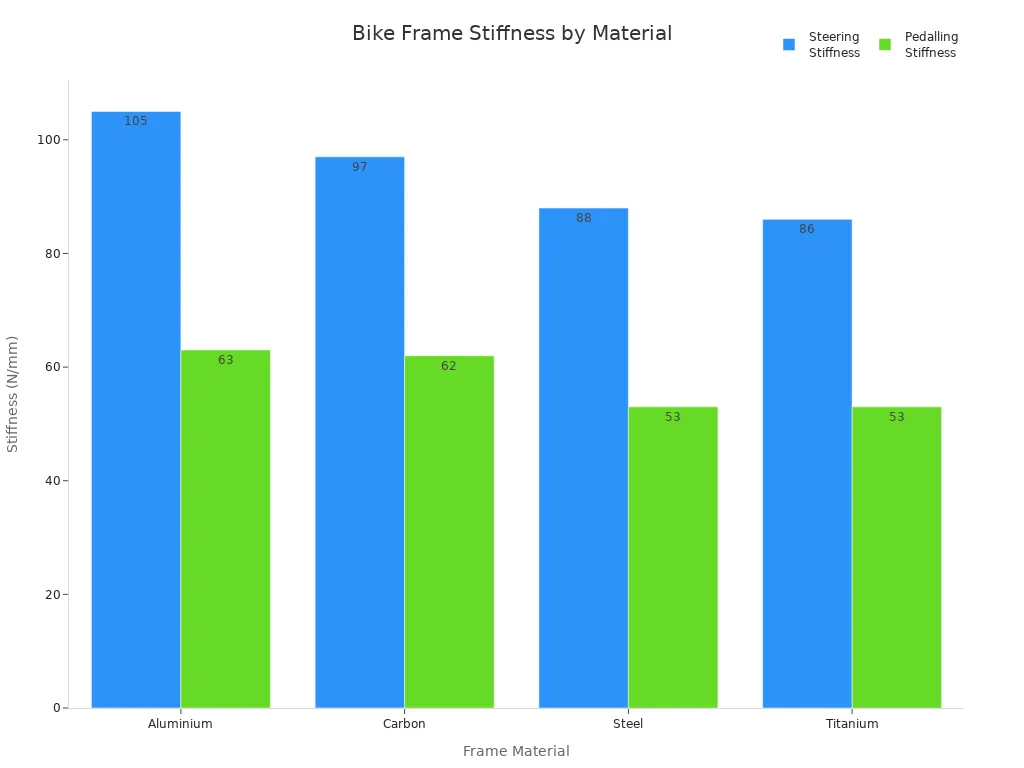
Lab tests also use simple checks like the “Front End Wiggle Test” and “Bottom Bracket Deflection Test.” These tests mean someone pushes on the frame and watches how much it bends. These tests are not as exact as lab machines. But they help people quickly see if a bike frame is stiff or flexible.
Real-World Feel
Rider testing helps match lab results to real riding. Engineers make lab tests to be like real rides. They look at numbers from tests and listen to what riders say. This helps them make sure their tests work well. Riders can feel if a bike frame is stiff or soft when they ride. Some riders like more vertical stiffness for strong pedaling. Others want more compliance for comfort.
Riders notice how frame stiffness changes how a bike feels.
Engineers test many frames with different stiffness levels.
Many riders can feel if a frame is stiff or flexible.
Riders have different opinions, so engineers use both lab data and rider feedback.
Big studies could show what most riders like, but they cost a lot.
Rider testing shows that not everyone wants the same stiffness. Some riders pick stiff frames for racing. Others want more compliance for rough trails. Lab tests and real riding help riders choose the best bike frame for them.
Balancing Stiffness & Compliance
Trade-Offs
Mountain bike engineers work hard to get the right mix of stiffness and compliance. Stiffness helps riders push hard on the pedals and go faster. It also makes the bike easier to steer on fast or tricky trails. But if the frame is too stiff, it can make the ride rough. Riders might feel more bumps and get tired faster.
Compliance helps the bike soak up bumps and trail noise. This makes rides smoother and keeps riders from getting tired. It also helps the wheels stay on the ground for better grip and control. But if the frame is too flexible, riders lose some power when they pedal. The bike might not react as fast, and it can feel slow during sprints.
Different types of mountain biking need different mixes of stiffness and compliance. VPP suspension is good for downhill racers who want strong pedaling and easy climbing. Single pivot designs are softer and help riders move smoothly through trails. Suspension travel matters too. Short travel setups are stiff for racing. Long travel setups are softer for downhill and comfort.
Tip: Riders should think about their main type of riding and goals when picking the right mix of stiffness and compliance.
Terrain & Riding Style
The type of trail changes what mix of stiffness and compliance is best. Smooth trails work well with stiff frames and less suspension. This setup gives strong pedaling, sharp turns, and a lively ride. Hardtail frames are good here because they are stiff and help riders pedal well.
Rough or steep trails need more compliance and longer suspension. Trail bikes and downhill bikes use these features to take in big bumps and keep riders comfy. Full suspension frames help with grip and comfort on rocky or rooty trails.
Smooth trails: Stiff frames, short travel, strong pedaling, quick turns.
Rough trails: More compliance, long travel, better comfort, more control.
Frame material changes how stiff or soft a bike feels. Aluminum frames are usually stiffer, which can make rough trails feel harsher. Carbon fiber frames let engineers change how stiff or soft the bike is for different trails and riding styles. This helps riders get the right feel for their needs.
Testing bikes in labs and on trails helps riders and engineers see how different setups work. The best mix of stiffness and compliance gives better pedaling, easier handling, and a more fun ride.
Choosing Your Mountain Bike Frame
Matching Compliance to Needs
Picking the right mountain bike frame starts with knowing how compliance changes comfort and performance. Riders should think about their weight, height, and how they ride. Bigger or heavier riders often need frames that are stiffer so they do not bend too much. Getting the right fit is very important. The shape of the frame, like the top tube and head tube, should match the rider’s size for comfort and safe riding. Some people need special tubing to make the frame more stiff or more flexible.
The material and shape of the tubes change how the bike feels, but how the builder puts it all together matters even more. Riders who weigh over 200 pounds might need custom frames or beam suspension frames. These frames help balance how much the frame bends up and down and how stiff it is. Wheel size matters too. Riders taller than 5’10” often like 700c wheels because they roll better and soak up bumps, making rides smoother on mountain trails.
Tires and how much air is in them also change how comfy the ride is. Lower tire pressure makes the ride softer, but heavy riders need to be careful not to get pinch flats. Some bikes have special parts like Trek’s IsoSpeed or Specialized’s FutureShock to add comfort that the frame alone cannot give. To get the right compliance, riders should think about frame size, shape, weight, tire setup, and any extra suspension parts.
Tips for Selection
When picking a mountain bike frame, riders should look at both how much the frame bends and what they want to use it for. Trying out different frames helps riders find what feels best for comfort and control. The table below shows how common frame materials compare for compliance:
Frame Material | Compliance Characteristics | Additional Notes |
|---|---|---|
Steel | Soaks up bumps well and gives a smooth ride | Heavy, strong, often used for custom or old bikes |
Carbon Fiber | Can be made stiff or soft by changing the shape | Light, can be shaped for comfort and stiffness |
Titanium | Light and strong, gives a comfy ride | Costs a lot, bends well for comfort |
Aluminum | Not as soft, but light and strong | Cheaper, used a lot for bike frames |
What riders want in compliance changes as they get more experience and ride in different ways. New riders and people who ride for fun usually want more comfort and a frame that bends more. Riders who are more skilled may want stiffer frames for better power and control on tough trails. The chart below shows how different riders like different levels of flex and compliance:
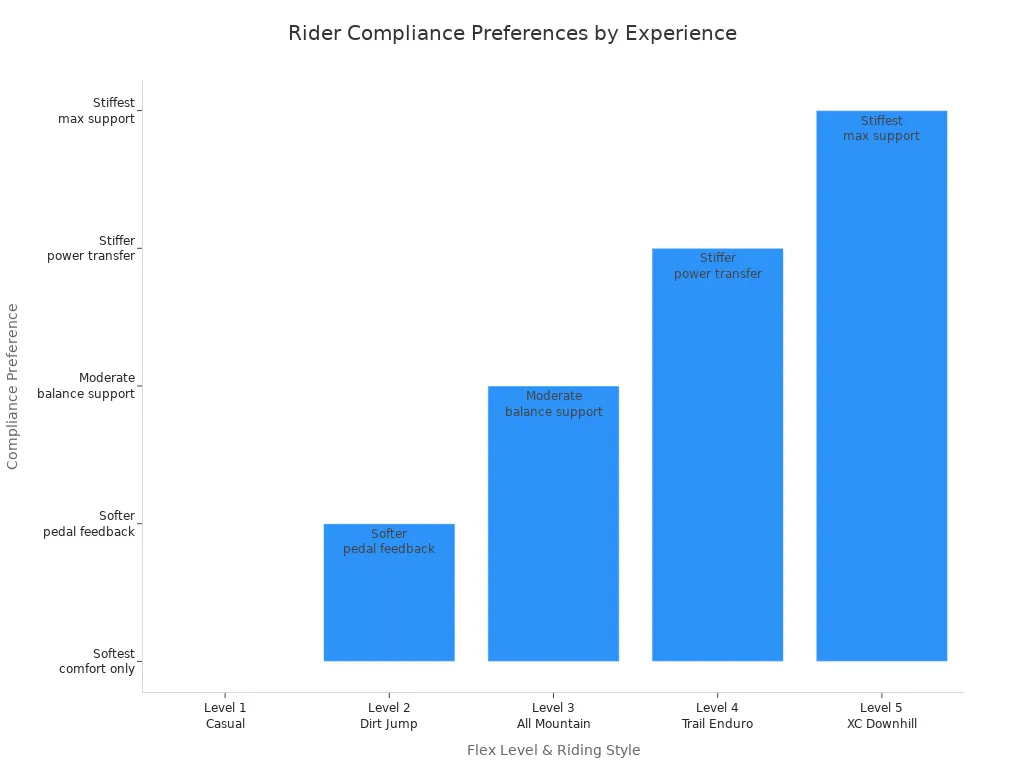
Tip: Riders should always try frames on real trails. Testing bikes helps make sure the frame gives the right mix of comfort, control, and compliance for mountain rides.
Mountain bike frame compliance affects how comfy and how well a bike works. Riders can feel when a frame is stiff enough to soak up bumps and still keep control. The right frame helps meet what each rider wants. Here are some main ideas:
Steel frames soak up lots of bumps and give smooth rides. Aluminum frames are stiff and light.
Suspension travel and frame shape should match the trail and how you ride. This helps get the best mix of stiffness and flex.
Experts say to pick a frame material and stiffness that fits your goals. This is true if you race, go on long trips, or ride trails for fun.
Frame Material | Stiffness | Compliance | Best For |
|---|---|---|---|
Carbon Fiber | Can be changed | Very flexible | Riders who want a special feel |
Titanium | Medium | Bends naturally | Riders who want comfort |
Steel | Not very stiff | Bends a lot | Smooth, strong rides |
Aluminum | Very stiff | Not much bend | Light, cheaper bikes |
Riders should try out different bikes and setups. They need to find the right stiffness for their trails and how they ride. The best bike frame gives comfort, control, and just the right amount of stiffness.
FAQ
What does frame compliance mean for mountain bike riders?
Frame compliance is how much a bike frame can bend. It also means how well it soaks up bumps and shakes. Riders feel smoother rides and better grip on the trail. Engineers test frames to see how much they flex when pushed.
How do manufacturers measure frame stiffness and compliance?
Manufacturers use lab tests to check frame stiffness and compliance. They push and pull on the frame in the lab. They watch how much each part bends. Tests like head tube deflection and bottom bracket flex are used. These tests help compare different frame materials.
Why does frame material affect ride quality?
Steel, aluminum, titanium, and carbon fiber all act differently. Steel bends more and soaks up bumps. Aluminum is stiffer and feels harder. Titanium is light and bends a bit. Carbon fiber lets engineers change how stiff or soft the frame is.
Can riders feel the difference between stiff and compliant frames?
Many riders can feel changes in comfort and control. Stiff frames send more power to the wheels. Compliant frames soak up bumps from the trail. Testing different frames helps riders pick what works best for them.
Should riders rely on lab testing or real-world testing?
Both lab and real-world tests are important. Lab tests give clear numbers for stiffness and compliance. Real-world tests show how the bike feels on trails. Riders should use both to find the best frame for their needs.
See Also
How To Choose The Perfect Bike Frame For You
Understanding Mountain Bike Geometry To Find Your Size
The Impact Of Selecting Correct Bike Frame Geometry
